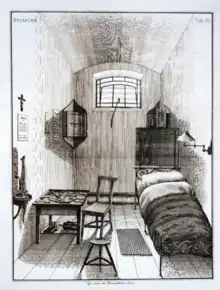 Front entrance to Saint-Gilles Prison | |
| Coordinates | 50°49′17″N 04°20′51″E / 50.82139°N 4.34750°E |
|---|---|
| Status | Operational (scheduled to close) |
| Capacity | 750 |
| Opened | 1884 |
| Street address | Avenue Ducpétiaux / Ducpétiauxlaan 106/N 242 |
| City | Saint-Gilles, Brussels-Capital Region |
| Postal code | 1060 |
| Country | Belgium |
| Notable prisoners | |
| Edith Cavell, Louise de Bettignies, Gabrielle Petit, Alexander von Falkenhausen | |
Saint-Gilles Prison (French: Prison de Saint-Gilles, Dutch: Gevangenis van Sint-Gillis) is a prison in Brussels, Belgium, that opened in 1884.[1] It is located on the borders of the municipalities of Saint-Gilles, Ixelles and Forest, next to Forest Prison and Berkendael Prison.
Representative of the cellular system established during the 19th century,[2] Saint-Gilles Prison was for a long time emblematic of overcrowding in Belgian prisons. Its infrastructure being in very poor condition, it is scheduled to close at the end of 2024, when it will be replaced by Haren Prison.[3]
History
Inception and construction

During the period of the establishment of the Kingdom of Belgium in 1830, the country's prisons were made up a motley collection of buildings that were not destined to become places of confinement. This was particularly true of the many religious houses that had been confiscated as national property after the second French invasion of 1794 during the French Revolutionary Wars.[4] In 1830, Édouard Ducpétiaux was appointed inspector-general of prisons for the Provisional Government, only a few months after the Belgian Revolution, and was assigned the task of organising the national prison system in accordance with the most modern standards.[5] In 1848, the cellular system of imprisonment was adopted, when a decree established the principle of individual imprisonment into penal law.[5] This led to a programme of prison building in the country from 1850 onwards.[5]
Saint-Gilles Prison was first planned in 1883 to replace the Petits Carmes Prison located in central Brussels.[6][7] The prison was designed by the Belgian architect Joseph Jonas Dumont and built by the Belgian-French engineer and sculptor Francois-Jacques Derre between 1878 and 1884.[6] It is representative of the cellular system established during the 19th century.[2] Originally a remand and sentencing prison, it housed people (men and women separately) placed under arrest warrant as preventive detention,[8] as well as those sentenced to police or correctional sentences for the judicial arrondissement of Brussels. After it proved insufficient to fulfil this dual function, the new Forest Prison located next door took on the role of remand prison in 1909.[9]
Incarceration during World War I

During World War I, with the exception of the territory behind the Yser river, Belgium was under German occupation. The Germans incarcerated at Saint-Gilles Prison those awaiting trial before the German Council of War in Brussels.[10] Individuals who were "part of clandestine networks, others who had publicly protested against the abuses of the occupying forces, or those who had attempted to cross the Dutch border" were systematically sentenced to imprisonment.[10] Some were transferred to Germany to serve their sentences. Several testimonies report violent treatment in the Brussels prison environment during this period, including cases of physical brutality, death threats and other acts of intimidation.[10]
Among the most notable women incarcerated at the prison were the English nurse Edith Cavell,[11] the French secret agent Louise de Bettignies,[12] and the Belgian spy Gabrielle Petit.[13] Petit's prison cell was preserved for posterity.[14] The following is a list of notable persons incarcerated in Saint-Gilles Prison and executed at the Tir national shooting range during the First World War:
A–D Joseph Baeckelmans Philippe Baucq Louise de Bettignies Mathieu Bodson Léon Boiteux Louis Bril Joseph Van der Cammen Edith Cavell Adelin Colon Jean-Baptiste Corbisier Paul Denis Joseph Delsaut Lucien Descamps Jules Descamps François Dufrasne E–H Alexandre Franck Louis Gille Emile Gressier Oscar Hernalsteens I–P Léon Jacquet Prosper Kricke Georges Kuge Louis Lefebvre Jules Legay Dominique Mertens Jules Mohr Louis Neyts Gabrielle Petit Pierre Poels François Mus Q–T Arthur Roland Charles Simonet Emile Stevigny U–Z Georges Uytebrouck François Vergauwen
Incarceration during World War II
During World War II, a large number of opponents of the German Nazi regime were imprisoned at Saint-Gilles Prison, either at the disposal of the German police, or to serve a sentence, or prior to their deportation to Germany, most often to Buchenwald. An infirmary was set up in the prison during the war, allowing prisoners from Fort Breendonk to be treated there.[15]
After the war, the leaders of the collaborators and of certain political and military organisations, as well as propagandists and spies were locked up at the prison.[16] Notably, General Alexander von Falkenhausen, military governor of Belgium and northern France during the occupation, was detained there from 1948 to 1951. The following is a list of notable persons incarcerated at Saint-Gilles Prison during the Second World War:
A–D Anne-Marie Basch André Bertulot Élise Binard Jean Burgers Marina Chafroff Aimé Dandoy Claire Duysburgh E–H Maximilien de Furstenberg Andrée De Jongh Louise de Landsheere Andrée Dumon Abraham Fogelbaum Arnaud Fraiteur Jean Franklemon Walter Ganshof van der Meersch Adelin Hartveld Arthur Haulot Marie-Louise Henin Pierre-Jean Herbinger I–P Albert Jonnart Maurice Kiek Régine Krochmal Simonne Lehouck-Gerbehaye Robert Lentz Alexandre Livchitz Mikhail Makarov Valentine Ployart Zofia Poznańska Q–T Alfred Steux U–Z Fernande Volral Berthe Warret Johann Wenzel Émile Witmeur
Later years and closure
In the 1980s, Jean Bultot, who was named in the Nijvel Gang case, was deputy director of Saint-Gilles Prison. In the decades that followed, many tensions arose at the prison, including due to overcrowding and staff shortages, leading to prisoner uprisings (such as in 1987 and 2009) and staff strikes.[17] Since the 1990s, the prison has been overcrowded, with about eight hundred inmates (mainly pre-trial detainees).[18][19] On 3 May 1993, the gangsters Murat, Lacroix and Bajrami escaped from the prison. They took then-inspector-general Harry Van Oers hostage, forced him onto the bonnet of their getaway car and drove out of the prison gate.[20]
As of 2023, Saint-Gilles Prison is scheduled to close. Three cell wings in the prison will remain in use until the end of 2024, when it will be replaced by Haren Prison.[3]
Location and accessibility

Saint-Gilles Prison is located at 106, avenue Ducpétiaux/Ducpétiauxlaan in Saint-Gilles, on the borders with Ixelles and Forest.[21] The rear of the surrounding wall borders the Avenue de la Jonction/Verbindingslaan, opposite Forest Prison. The two prisons are connected by an underground passage used to serve to transfer prisoners. This close proximity causes frequent confusion between the two prisons in the media.
The Brussels-Capital Region has, in total, three prisons in the area: Saint-Gilles Prison, Forest Prison, as well as its women's quarter (known as Berkendael Prison), whose separate entrance opens onto the Rue de Berkendael/Berkendaalstraat. This site is served by the premetro (underground tram) station Albert (on lines 3 and 4), as well as the bus stop Prison/Gevangenis (on line 54).[22]
Controversies
Detention conditions
In terms of detention conditions, Saint-Gilles Prison is marked by chronic overcrowding. Despite slight improvements, reports from the European Committee point to an overcrowding rate that still hovers around 50%. In 2017, the annual report of the General Directorate of Penitentiaries reported that, since the prison took over its function as a remand centre in 2016, there have been 896 male inmates for 579 places,[18] representing an average prison overcrowding rate of 48%.[19] This situation persists and is the cause of numerous staff strikes, the main effect of which is to further deteriorate detention conditions.[23][24]
Since 2020 and the outbreak of the COVID-19 pandemic in Belgium, the situation has become even more tense. The application of measures such as social distancing is impossible in an overcrowded prison: 903 inmates for 850 places on 24 November 2021, bearing in mind that this increase in capacity has only been achieved by putting cells designed for a single inmate into "duos" or "trios". This has led to the emergence of multiple "clusters" of infection, prompting the mayor of Saint-Gilles, Charles Picqué, to issue an order prohibiting new entries.[23][24]
Convictions
On the Belgian judicial front, the main conviction stems from a judgment of the Brussels Tribunal of First Instance on 9 January 2019.[25] The case was brought by the French- and German-speaking Bar Associations. The latter accused the Belgian State of serious failings regarding detention conditions at Saint-Gilles Prison. The judgement highlighted the problem of increasing prison overcrowding at the facility, which is in breach of Belgium's international and European commitments on prison conditions.[19] At the end of the proceedings, the court ordered the Belgian State to reduce the number of inmates at Saint-Gilles Prison to the facility's official capacity. If it fails to do so, the Belgian State is also liable to the payment of penalties, the amount of which increases in the event of non-compliance by the State with the obligation imposed on it.[25]
At international and European level, proceedings have also been initiated against Belgium. Indeed, the European Court of Human Rights has condemned the Belgian State for violating the European Convention on Human Rights through the detention conditions at Saint-Gilles Prison.[26]
See also
- Red Orchestra ("Rote Kapelle")
- History of Brussels
- Belgium in the long nineteenth century
References
Citations
- ↑ "Plus d'infos sur la prison de Saint-Gilles" [More information on Saint-Gilles prison]. Service public fédéral de justice (SPF Justice) (in French). Retrieved 3 September 2023.
- 1 2 Feyaerts 2018, p. 17–31.
- 1 2 "Haren (Brussel) Gevangenis(dorp) Federale Overheidsdienst Justitie" [The Haren (Brussels) Prison (village) Federal Public Service of Justice] (in Dutch). 4 October 2022.
- ↑ Stevens 1885, pp. 327–346.
- 1 2 3 Vanhulle 2010, pp. 107–130.
- 1 2 Picqué 2016, p. 150.
- ↑ "Prison de Saint-Gilles". Inventaire du patrimoine architectural (in French). Collection cartes postales Dexia Banque. CHDStG. Retrieved 3 September 2023.
- ↑ "Prisons belges". Service public fédéral de justice (SPF Justice) (in French). Retrieved 1 October 2023.
- ↑ "Prison de Forest – Inventaire du patrimoine architectural". monument.heritage.brussels (in French). Retrieved 1 October 2023.
- 1 2 3 Debruyne, Reszöhazy & Van Ypersele 2018, p. 65–90.
- ↑ Hoehling 1957, p. 1320.
- ↑ "Louise de Bettignies 1880-1918". Chemins de Mémoire. Paris: Ministère des Armées. Retrieved 1 October 2023.
- ↑ "Gabrielle Petit 1893-1916". Chemins de Mémoire. Paris: Ministère des Armées. Retrieved 28 September 2023.
- ↑ Pickles 2016, p. 198.
- ↑ Maerten 2016.
- ↑ "Inventaire des archives de la prison de Saint-Gilles - Archives de l'État en Belgique". www.arch.be (in French). Retrieved 28 September 2023.
- ↑ Deceulaer, De Prins & Tallier 2019.
- 1 2 "Rapport annuel de la direction générale Etablissements pénitentiaires (DG EPI)" (PDF). Service public fédéral de justice (SPF Justice) (in French). 2017. p. 44. Retrieved 1 October 2023.
- 1 2 3 "Rapport au Gouvernement de la Belgique relatif à la visite effectuée en Belgique par le Comité européen pour la prévention de la torture et des peines ou traitements inhumains ou dégradants (CPT)". Conseil de l'Europe (in French). 8 March 2018. p. 5. Retrieved 1 October 2023.
- ↑ Van Oers 2010.
- ↑ "Prison de Saint-Gilles". Service public fédéral de justice (SPF Justice) (in French). Retrieved 28 September 2023.
- ↑ "Ligne 54 vers TRONE - stib.be". Stib Mvib. Retrieved 28 September 2023.
- 1 2 "Prison de St-Gilles: le bourgmestre a pris un arrêté pour limiter la population carcérale". Le Soir (in French). 23 November 2021. Retrieved 29 October 2023.
- 1 2 BELGA (29 October 2023). "Charles Picqué interdit l'entrée de nouveaux détenus à la prison de Saint-Gilles". La Libre.be (in French). Retrieved 29 October 2023.
- 1 2 Tribunal de première instance francophone de Bruxelles, Section Civile (11 January 2019). "Jugement, 4ème chambre affaire civiles" (PDF). Retrieved 29 October 2023.
- ↑ Cour eur. D.H., arrêt Dufoort c. Belgique, 10 April 2013; Cour eur. D.H., arrêt Swennen c. Belgique, 10 April 2013; Cour eur. D.H., arrêt Claes c. Belgique, 10 April 2013.
Bibliography
- Debruyne, Emmanuel; Reszöhazy, Elise; Van Ypersele, Laurence (2018). "Dans les mains de la police allemande. Les violences carcérales et policières comme expérience d'occupation en Belgique, 1914-1918" [In the hands of the German police. Police and prison violence as an experience of occupation in Belgium, 1914-1918.]. Guerres Mondiales et Conflits Contemporains. 272 (4): 65. doi:10.3917/gmcc.272.0065.
- Deceulaer, Harald; De Prins, Gert; Tallier, Pierre-Alain (2019). Inventaris van het archief van de gevangenis van Sint-Gillis, 1885-1991 (in Dutch). Algemeen Rijksarchief. ISBN 978-94-6391-021-7.
- Feyaerts, Jozefien (2018). "Building services in nineteenth-century Belgian cellular prison architecture". In Campbell, James W.P.; Baker, Nina; Boyington, Amy; Driver, Michael; Heaton, Michael; Pan, Yiting; Schoenefeldt, Henrik; Tutton, Michael; Yeomans, David (eds.). Studies in the History of Services and Construction The proceedings of the Fifth Conference of the Construction History Society. Cambridge: University of Cambridge. ISBN 978-0-9928751-4-5.
- Hoehling, A. A. (1957). "The Story of Edith Cavell". The American Journal of Nursing. 57 (10): 1320–1322. doi:10.2307/3461516. JSTOR 3461516.
- Maerten, Fabrice (16 March 2016). "Parcours de résistant. De l'arrestation à la déportation" (PDF). Démocratie ou barbarie (in French). Retrieved 28 September 2023.
- Picqué, Charles (2016). Saint-Gilles : Huit siècles d'histoires 1216-2016 (in French). Mardaga. ISBN 978-2-8047-0343-1.
- Pickles, K. (2016). Transnational Outrage: The Death and Commemoration of Edith Cavell. Basingstoke, New York: Springer. ISBN 978-0-230-28608-5.
- Stevens, J (19 September 1885). "Rapport". Actes du Congrès pénitentiaire international de Rome, novembre (in French). Vol. 3, Part 1. Saint Gilles, Brussels.
{{cite book}}: CS1 maint: location missing publisher (link) - Vanhulle, Bert (2010). "Dreaming about the prison: Édouard Ducpétiaux and Prison Reform in Belgium (1830- 1848)". Crime, Histoire & Sociétés / Crime, History & Societies. Librairie Droz. 14 (2): 107–130. JSTOR 42708789.
- Van Oers, Harry (2010). De dag van de grote ontsnapping (in Dutch). Antwerp: Witsand. ISBN 9789490382377.
External links
 Media related to Saint-Gilles prison at Wikimedia Commons
Media related to Saint-Gilles prison at Wikimedia Commons- Inventory of the archives of the Saint-Gilles prison, 1885-1991